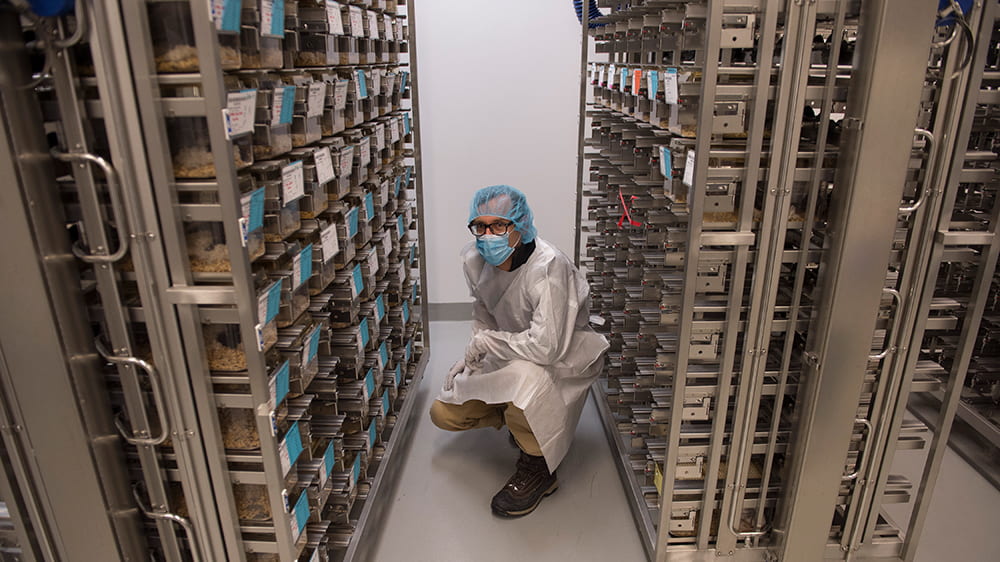by Elise Wachspress
If you are a subscriber to the DFI blog (Easy! Free! See the box to the right!) or a regular reader, you’ve seen and heard a lot about mice. So much of what we have learned thus far about the interplay between the microbiome, immunity, and genetics comes from experiments with these little animals. Why?
Mice have historically been used in a lot of biomedical research. They are small and comparatively less costly to raise and house than other animals, reproduce quickly and often and have a short life span, thus studies can be conducted relatively quickly. Researchers have learned a lot about how to manipulate mice’s genetic inheritance, so the critters can make good models for some human diseases where we know the specific genes at work.
Mice have been especially useful for studying the effects of the gut microbiome, in diseases from obesity to cancer. Their intestinal track is similar to ours, with comparable anatomical features and many of the same kinds of cells—although there are some important differences.
Unlike humans, mice have a fore-stomach that holds food before digestion, creating an entry to the system much less acidic than our stomachs. Our intestines have more folds and a thicker mucus layer—an environment more friendly for bacteria looking to set up homes. The cecum, a part of the large intestine, is relatively larger in mice, offering a better place for microbial fermentation of indigestible fiber. And humans have an appendix, a place for bacteria to hang out when disaster (like diarrhea or other intestinal problems) strikes, the better to repopulate the intestines when the crisis is over.
Despite these caveats, mouse models have proven their value in gut microbiome studies, helping researchers understand some of the complex mechanisms that underlie diabetes, celiac, inflammatory bowel and others diseases. Mice offer huge practical advantages: researchers can readily control their diet, treat them with antibiotics, and transplant them with bacteria—unlike with humans, who are, none-the-less, the ultimate beneficiaries of these experiments.
Of course, transplanting mice with bacteria only works if the mice start out with either no bacteria or very well-characterized bacteria, so researchers can parse out the effects caused by the new microbial additions. After birth, the mice must continue to live their entire lives in an aseptic (no new bacteria) environment—and stay far away from others, as mice have a known habit of eating their cagemates’ poop. Managing this complicated endeavor is where Betty Theriault, DVM, and UChicago’s Gnotobiotic Research Animal Facility (GRAF) come in.
The word gnotobiotic is a mashup of two Greek roots, “known” and “alive.” The premise for the gnotobiotic facility is to understand exactly what microorganisms are alive in each mouse. The GRAF specializes in managing animals free of all organisms (bacteria, viruses, fungi and parasites) and gnotobiotic animals—those who have been intentionally inoculated with a well-defined set of microbes.
Established in 2007, the GRAF is now one of the largest and most successful academic gnotobiotic mouse facilities in the world, with over 90 flexible isolators. Theriault and her crew of 13 dedicated, full-time personnel maintain hermetically sealed, individually ventilated cages on rack systems—think sterile condominium units for mice—which assure each mouse is living with only the microbes it came in with. In 2017, the GRAF was named international laboratory animal team of the year award; you can take a three-minute tour of their approach on YouTube.
Theriault is a veterinarian with three decades of experience working with a broad spectrum of animal species in a variety of settings. After vet school at the University of California, Davis and an internship in Small Animal Medicine and Surgery at Penn, she came to UChicago to advance transplantation immunology research. Although she left for a while to pursue private practice, she returned to UChicago fifteen years ago to develop the GRAF, which is accredited by the Association for Assessment and Accreditation of Laboratory Animal Care International, a private nonprofit that promotes the humane treatment of animals in science. (You can watch Theriault present on the challenges involved in setting up a gnotobiotic facility at the National Academies of Sciences, Engineering, and Medicine in 2017).
So what’s the future of gnotobiotic research? Studies have shown that germ-free mice successfully support complex fecal microbiota from humans in their gastrointestinal tracks. Researchers anticipate mouse models will be increasingly useful in predicting patient outcomes to therapeutic interventions or informing personalized approaches to patient care.
While knowledge gained from animal models is not always directly transferable to humans, UChicago’s Gnotobiotic Research Animal Facility is helping us understand many more of the mechanisms at work between our gut microbes and our health, providing insights that may help us live longer, healthier lives.
Elise Wachspress is a senior communications strategist for the University of Chicago Medicine & Biological Sciences Development office




